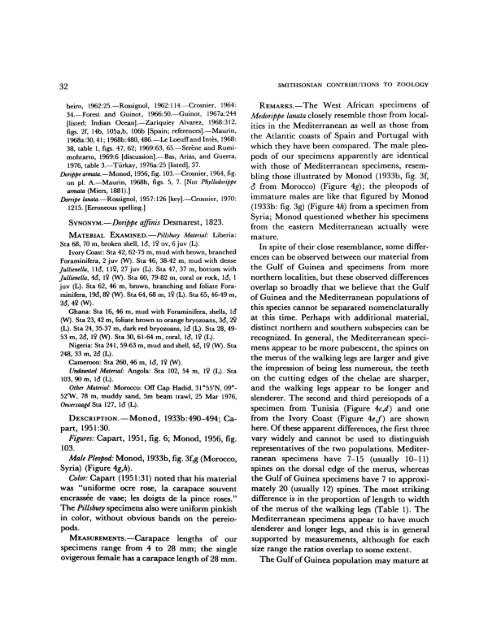West African Brachyuran Crabs - Smithsonian Institution Libraries
West African Brachyuran Crabs - Smithsonian Institution Libraries
West African Brachyuran Crabs - Smithsonian Institution Libraries
You also want an ePaper? Increase the reach of your titles
YUMPU automatically turns print PDFs into web optimized ePapers that Google loves.
32<br />
beiro, 1962:25.—Rossignol, 1962:114.—Crosnier, 1964:<br />
34.—Forest and Guinot, 1966:50.—Guinot, 1967a:244<br />
[listed; Indian Ocean].—Zariquiey Alvarez, 1968:312,<br />
figs. 2f, 14b, 105a,b, 106b [Spain; references].—Maurin,<br />
1968a:30,41; 1968b:480, 486.—Le Loeuffand Intes, 1968:<br />
38, table 1, figs. 47, 62; 1969:63, 65.—Serene and Romimohtarto,<br />
1969:6 [discussion].—Bas, Arias, and Guerra,<br />
1976, table 3.—Tiirkay, 1976a:25 [listed], 37.<br />
Dorippe armata.—Monod, 1956, fig. 103.—Crosnier, 1964, fig.<br />
on pi. A.—Maurin, 1968b, figs. 5, 7. [Not Phyllodorippe<br />
armata (Miers, 1881).]<br />
Dorripe lanata.—Rossignol, 1957:126 [key].—Crosnier, 1970:<br />
1215. [Erroneous spelling.]<br />
SYNONYM.—Dorippe qffinis Desmarest, 1823.<br />
MATERIAL EXAMINED.—Pillsbury Material: Liberia:<br />
Sta 68, 70 m, broken shell, 16\ 1$ ov, 6 juv (L).<br />
Ivory Coast: Sta 42, 62-75 m, mud with brown, branched<br />
Foraminifera, 2 juv (W). Sta 46, 38-42 m, mud with dense<br />
Jullienella, lie?, 11$, 27 juv (L). Sta 47, 37 m, bottom with<br />
Jullienella, 46*, 19 (W). Sta 60, 79-82 m, coral or rock, 1(5, 1<br />
juv (L). Sta 62, 46 m, brown, branching and foliate Foraminifera,<br />
19(5, 89 (W). Sta 64, 68 m, 19 (L). Sta 65, 46-49 m,<br />
26, 49 (W).<br />
Ghana: Sta 16, 46 m, mud with Foraminifera, shells, 1(5<br />
(W). Sta 23, 42 m, foliate brown to orange bryozoans, 36, 29<br />
(L). Sta 24, 35-37 m, dark red bryozoans, 1(5 (L). Sta 28, 49-<br />
53 m, 26, 19 (W). Sta 30, 61-64 m, coral, 1(5, 19 (L).<br />
Nigeria: Sta 241, 59-63 m, mud and shell, 4c?, 19 (W). Sta<br />
248, 33 m, 26 (L).<br />
Cameroon: Sta 260, 46 m, 1(5, 19 (W).<br />
Undaunted Material: Angola: Sta 102, 54 m, 19 (L). Sta<br />
103, 90 m, 16 (L).<br />
Other Material: Morocco: Off Cap Hadid, 31°55'N, 09°-<br />
52'W, 78 m, muddy sand, 5m beam trawl, 25 Mar 1976,<br />
Onversaagd Sta 127, 1(5 (L).<br />
DESCRIPTION.—Monod, 1933b:490-494; Capart,<br />
1951:30.<br />
Figures: Capart, 1951, fig. 6; Monod, 1956, fig.<br />
103.<br />
Male Pleopod: Monod, 1933b, fig. 3f,g (Morocco,<br />
Syria) (Figure 4g,h).<br />
Color: Capart (1951:31) noted that his material<br />
was "uniforme ocre rose, la carapace souvent<br />
encrassee de vase; les doigts de la pince roses."<br />
The Pillsbury specimens also were uniform pinkish<br />
in color, without obvious bands on the pereiopods.<br />
MEASUREMENTS.—Carapace lengths of our<br />
specimens range from 4 to 28 mm; the single<br />
ovigerous female has a carapace length of 28 mm.<br />
SMITHSONIAN CONTRIBUTIONS TO ZOOLOGY<br />
REMARKS.—The <strong>West</strong> <strong>African</strong> specimens of<br />
Medorippe lanata closely resemble those from localities<br />
in the Mediterranean as well as those from<br />
the Atlantic coasts of Spain and Portugal with<br />
which they have been compared. The male pleopods<br />
of our specimens apparently are identical<br />
with those of Mediterranean specimens, resembling<br />
those illustrated by Monod (1933b, fig. 3f,<br />
6* from Morocco) (Figure 4g); the pleopods of<br />
immature males are like that figured by Monod<br />
(1933b: fig. 3g) (Figure Ah) from a specimen from<br />
Syria; Monod questioned whether his specimens<br />
from the eastern Mediterranean actually were<br />
mature.<br />
In spite of their close resemblance, some differences<br />
can be observed between our material from<br />
the Gulf of Guinea and specimens from more<br />
northern localities, but these observed differences<br />
overlap so broadly that we believe that the Gulf<br />
of Guinea and the Mediterranean populations of<br />
this species cannot be separated nomenclaturally<br />
at this time. Perhaps with additional material,<br />
distinct northern and southern subspecies can be<br />
recognized. In general, the Mediterranean specimens<br />
appear to be more pubescent, the spines on<br />
the merus of the walking legs are larger and give<br />
the impression of being less numerous, the teeth<br />
on the cutting edges of the chelae are sharper,<br />
and the walking legs appear to be longer and<br />
slenderer. The second and third pereiopods of a<br />
specimen from Tunisia (Figure Ac,d) and one<br />
from the Ivory Coast (Figure AeJ) are shown<br />
here. Of these apparent differences, the first three<br />
vary widely and cannot be used to distinguish<br />
representatives of the two populations. Mediterranean<br />
specimens have 7-15 (usually 10-11)<br />
spines on the dorsal edge of the merus, whereas<br />
the Gulf of Guinea specimens have 7 to approximately<br />
20 (usually 12) spines. The most striking<br />
difference is in the proportion of length to width<br />
of the merus of the walking legs (Table 1). The<br />
Mediterranean specimens appear to have much<br />
slenderer and longer legs, and this is in general<br />
supported by measurements, although for each<br />
size range the ratios overlap to some extent.<br />
The Gulf of Guinea population may mature at

















